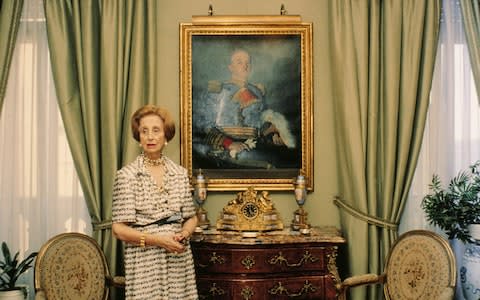Christie's urged to suspend sale of Franco family jewels activists say were stolen from the state

Victims of Spanish dictator Francisco Franco have demanded that Christie's halt the sale of £350,000 of family jewels to stop the descendants of the fascist leader profiting from his ill-gotten gains.
As part of a November 27 auction in London entitled “Important Jewels”, three lots comprising a large diamond ring, an art deco emerald necklace and a pair of Cartier emerald earrings encrusted with diamonds are advertised discreetly as “the property of a Spanish family”.
But families of victims of the dictatorship, who ruled Spain from the end of a bloody civil war in 1939 until his death in 1975, argue that the jewels are part of a family legacy “built on corruption, pillage and embezzlement”. They say the origin of the fortune should be investigated before allowing Franco’s heirs to pocket money from sales.
In a letter seen by The Telegraph, the Association for the Recovery of Historical Memory (ARMH), which represents Franco victims, asks the Spanish Embassy to demand that Christie’s reveal the documents that accredit the Franco family with ownership, adding that, otherwise, the auction house could be acting as an “accessory” to an illegal sale.
The ARMH has also asked the Spanish culture ministry whether it has investigated the origin of the jewels.

Asked whether Christie’s was aware of the controversy concerning the Franco family’s gems, a spokesperson said: “We respect and maintain the confidentiality of our clients out of courtesy to them and in line with market practices:”
Carmen Franco Polo, the dictator’s only child, died in December 2017, leaving a fortune estimated to be worth more than 100 million euros to be divided between her seven children.
Among the family’s most controversial possessions is the Pazo de Meirás, a palace in northwestern Spain put on sale last year by Franco’s grandchildren at a price of £7 million, despite a dispute over whether the building constitutes private or state property. The government of Mr Sánchez has since moved to reclaim the palace for the state through the courts.
Santiago de Compostela’s council is also suing the family for the return of two 12th century sculptures from the city’s cathedral that are kept in the Pazo, allegedly after Franco’s wife, Carmen Polo, once took a liking to them in an exhibition of religious art.

Franco’s body was exhumed from a tomb in the colossal Valley of the Fallen mausoleum near Madrid last month by the Socialist party government of acting prime minister Pedro Sánchez. The move came after a fierce legal battle waged by the dictator’s grandchildren, the Francisco Franco Foundation and members of the Catholic Church.
This week a plan was announced to allow the first-ever removal of some of the more than 33,000 civil war victims from the crypt of the basilica, where Franco was buried.
Spain’s National Heritage body, which oversees state property including the Valley of the Fallen, told families of 31 victims that work will start next month. Authorities will dig up the crypt’s ossuaries, large boxes of human remains that were often taken to the mausoleum during the dictatorship without the permission of families.
Most of the victims whose families wish to have removed were from the Republican side in the war, including men who were summarily executed and initially heaped into mass graves.
But Silvino Gil was furious when he found out 12 years ago that his father, Pedro Gil Calonge, who fought on Franco’s side, had been dug up from a cemetery in Zaragoza to help fill the dictator’s vast crypt. “Who the hell was Franco to take my father away?” the 83-year-old said.

 Yahoo News
Yahoo News 
